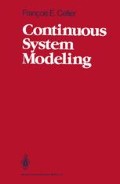Abstract
In the last chapter, we discussed a crude approach to analyzing the behavior of a system by means of a coarse, qualitative, structural description of the real physical system. The claim was that this models the way humans reason about processes, and since humans are very adept at making correct decisions on the basis of incomplete knowledge, this approach may enable algorithms to duplicate such aptitude. It turned out that the results were not as promising as some researchers would like us to believe. Strong indicators can also be found that humans mostly assess the behavior of a system not on the basis of qualitative physical considerations, but on the basis of analogies with similar processes, the operation of which they have previously observed, i.e., that they use pattern recognition to analyze system behavior. In this chapter, we shall discuss one of several pattern recognition techniques that may be able to mimic how humans apply pattern recognition to reason about system behavior.
Access this chapter
Tax calculation will be finalised at checkout
Purchases are for personal use only
Preview
Unable to display preview. Download preview PDF.
References
François E. Ceffier (1987), “Prisoner’s Dilemma Revisited — A New Strategy Based on the General System Problem Solving Framework,” International J. of General Systems, 13 (4), pp. 323–332.
François E. Cellier (1987), “Qualitative Simulation of Technical Systems Using the General System Problem Solving Framework,” International J. of General Systems, 13 (4), pp. 333–344.
François E. Cellier (1991), “General System Problem Solving Paradigm for Qualitative Modeling,” in: Qualitative Simulation, Modeling, and Analysis ( P.A. Fishwick and P.A. Luker, eds.), Springer-Verlag, New York, pp. 51–71.
François E. Cellier and David W. Yandell (1987), “SAPS-II: A New Implementation of the Systems Approach Problem Solver,” International J. of General Systems, 13 (4), pp. 307–322.
George J. Klir (1985), Architecture of Systems Problem Solving, Plenum Press, New York.
George J. Klir (1989), “Inductive Systems Modelling: An Overview,” Modelling and Simulation Methodology: Knowledge Systems’ Paradigms (M.S. Elzas, T.I. Oren, and B.P. Zeigler, eds.), Elsevier Science Publishers B. V. ( North-Holland), Amsterdam, The Netherlands.
Averill M. Law and W. David Kelton (1990), Simulation Modeling and Analysis, second edition, McGraw-Hill, New York.
DongHui Li and François E. Cellier (1990) “Fuzzy Measures in Inductive Reasoning,” Proceedings.1990 Winter Simulation Conference, New Orleans, La., pp. 527–538.
Glenn Shafer (1976), A Mathematical Theory of Evidence, Princeton University Press, Princeton, N.J.
Claude E. Shannon and Warren Weaver (1964), The Mathematical Theory of Communication, University of Illinois Press, Urbana.
Hugo J. Uyttenhove (1979), SAPS — System Approach Problem Solver, Ph.D. dissertation, SUNY Binghampton, N.Y.
Pentti J. Vesanterii and François E. Cellier (1989), “Building Intelligence into an Autopilot — Using Qualitative Simulation to Support Global Decision Making,” Simulation, 52 (3), pp. 111–121.
Lotfi A. Zadeh (1985), “Syllogistic Reasoning in Fuzzy Logic and Its Application to Usuality and Reasoning with Dispositions,” IEEE Trans. Systems, Man, and Cybernetics,SMC-15(6), pp. 754–763.
Lotfi A. Zadeh (1986), “A Simple View of the Dempster-Shafer Theory of Evidence and Its Implication for the Rule of Combination,” The AI Magazine, Summer Issue, pp. 85–90.
Lotfi A. Zadeh (1987), “A Computational Theory of Dispositions,” International J. of Intelligent Systems, 2, pp. 39–63.
Bibliography
Russell L. Ackoff (1978), The Art of Problem Solving, WileyInterscience, New York.
Ludwig von Bertalanffy (1969), General System Theory: Foundations, Development, Applications, G. Braziller Publishing, New York.
G. Broekstra (1978), “On the Representation and Identification of Structure Systems,” International J. of Systems Science, 9 (11), pp. 1271–1293.
Brian R. Gaines (1979), “General Systems Research: Quo Vadis,” General Systems Yearbook, 24, pp. 1–9.
George J. Klir, Ed. (1978), Applied General Systems Research, Plenum Press, New York.
Allan Newell and Herbert A. Simon (1972), Human Problem Solving, Prentice—Hall, Englewood Cliffs, N.J.
John L. Pollock (1990), Monic Probability and the Foundations of Induction, Oxford University Press, New York.
Joseph E. Robertshaw, S. J. Mecca, and M. N. Rerick (1979), Problem Solving: A Systems Approach, McGraw—Hill, New York.
Herbert A. Simon (1972), “Complexity and the Representation of Patterned Sequences of Symbols,” Psychological Reviews, 79, pp. 369–382.
Herbert A. Simon (1977), Models of Discovery and Other Topics in the Methods of Science, Reidel Publishing, Boston, Mass.
G. Towner (1980), The Architecture of Knowledge, University Press of America, Washington, D.C.
Author information
Authors and Affiliations
Rights and permissions
Copyright information
© 1991 Springer Science+Business Media New York
About this chapter
Cite this chapter
Cellier, F.E. (1991). Inductive Reasoning. In: Continuous System Modeling. Springer, New York, NY. https://doi.org/10.1007/978-1-4757-3922-0_13
Download citation
DOI: https://doi.org/10.1007/978-1-4757-3922-0_13
Publisher Name: Springer, New York, NY
Print ISBN: 978-1-4757-3924-4
Online ISBN: 978-1-4757-3922-0
eBook Packages: Springer Book Archive

